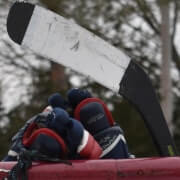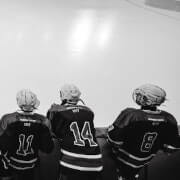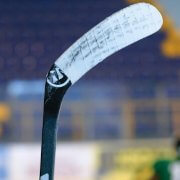What Is a Good Age to Start Playing Hockey? Take a Look!

When To Start Playing Hockey
If you are eager to share your love and passion for the game of hockey with your kid, you probably cannot wait to get them in skates and put them out on the ice. However, you are probably wondering how old they have to be to play the game and play competitively.
A good age to start playing hockey is five years old as that is when they can be placed into organized hockey. However, it is common to have them learn how to skate as early as three years old. They can also learn how to hold the stick and play safely at this age.
Whether your child has been begging you to get them on the ice, or you are just considering your options for what sports to put your kid in, hockey is a great one to start at a young age. If you want to learn more about how to know if your kid is ready to start playing hockey and how old they have to be to do so, keep reading.
What Skills Are Needed to Play Hockey?
While many of the skills required to play hockey will be taught within a hockey program, it’s still important to understand what they are as it can be a good determiner if your child is ready to play.
The most critical skill, and one that can be taught early to your child at the young age of 2 or 3 years old, is skating. Not long after they learn how to walk, you can begin teaching them how to skate or put them in a skating program where they can learn. Since hockey is played on ice, learning how to play hockey and collaborate with a team will be a lot more difficult without knowing how to skate.
Here is a list of some other skills that are needed to play hockey:
- Ability to utilize balance and agility while skating
- Can skate both backward and forward at a consistent speed
- Can handle the puck properly, which is strongly based on the ability to skate properly
- Can pass the puck to other players on the ice
- Ability to shoot the puck towards the net
- Endurance, so they can play through an hour-long game
- Soft skills such as quick-thinking and problem solving so you can make decisions while on the ice
While a young child doesn’t need to have any of these skills before they enter into organized hockey, it is best that they at least know how to skate around the ice while holding a stick when they begin.
Does My Child Have the Skills to Start Hockey?
If you are trying to determine if your child is ready to start hockey, while they do not need any of the skills listed above right at the get-go, there are a few things that will be important when they join.
These skills include:
- Communication: The ability to verbalize their own needs and talk with adults
- Good listening: The ability to listen to instructions and understand general requests from adults
- Ability to follow instructions: The ability to follow instructions given to them by their coaches; however, within reason as not all children are going to follow instructions all the time
- Basic physical skills: This includes balance, muscle strength, and a certain level of hand-eye coordination
Typically, your child will learn these skills throughout elementary school, so you won’t have to worry too much, but if they are still under eight years old and seem a little behind, introducing them slowly may be a good option.
If you are nervous about your kid joining hockey too soon, or if you think that they seem to be smaller or a little behind others their age, there are other options that you can look into. This way, they can still build their skills and be ready for when they join organized hockey.
Some of these options include but are not limited to:
- Skating Lessons
- Power Skating Lessons
- Public Skating
- Mom and Tots
- Outdoor Rinks
- Road Hockey
Introducing them to one of the options above first, especially ones done with other people, can get them ready to be on a team with scheduled practices, games, and tournaments.
What Age Should a Child Be to Play Hockey?
Most organized hockey begins at the age of 5, so it isn’t likely they will play a real game until then. However, they will likely get to skate around on the ice before then. So, there really is no proper age for them to begin, but if you are looking to sign them up within an organized team, they will have to be at least five years old.
At this age, you will be able to tell if the sport is something that they like or don’t like and proves to be a good time for many to get started. At this age, they are also old enough to understand the concept of the game a bit more; any younger and you are likely to have a bunch of reluctant kids who would rather skate around and ignore the idea of getting a puck in a net.
Although this may not be true for every kid, if you think the time is right, you can always buy them their own puck and stick and have them practice a bit on their own if they are still too young to join an official youth hockey team.
Should You Start Young?
With children being able to join organized hockey at the age of 5, there seems to be no better time to get them started. By starting them at a young age, they will have plenty of time to practice skating and playing the game. However, just because they start later than five years old does not mean that they will be a worse player, as discussed in our article titled “Is 13 Too Old To Start Hockey? We Don’t Think So“.
What Age Can a Child Learn to Skate?
As previously mentioned, many people will enroll their children in skating as young as 2 to 3 years old, which overall helps them get used to the feeling of skating and allow them to build the necessary skills to skate forward, stop and make turns.
By being able to skate well by the age of 5, it will enormously benefit the player as they are then able to focus on learning the game and learning the technique and skills required to play a game of hockey, instead of just focusing on how to stay balanced and make quick turns or stops.
What to Consider When Starting Hockey
Once you decide to play hockey or enroll your kid in hockey, you will want to be prepared. This includes having the right equipment, getting a stick that’s the right size, and understanding what classification to enroll them in.
If you are interested in learning more about all of the aspects of enrolling your kid in hockey either at the age of 5 or later on in their life, keep reading below.
Having Properly Fitted Equipment
One of the most important aspects of playing hockey is safety, which comes from the equipment that gets worn on the ice, including a helmet and other protective gear. Not only do they need this equipment, but having equipment that fits properly is how you can guarantee that it will do its job at keeping the player safe.
If your child is small, it is best not to enroll them in hockey until you have equipment that fits them. We have another article that focuses on how to fit youth hockey equipment properly.
Proper protective equipment includes:
- Helmet
- Shoulder pads/chest protector
- Elbow pads
- Mouthguard
- Protective gloves
- Heavily padded shorts
- A jock
- Shin guards
- Neck guard
Other equipment you will need include:
- Hockey Stick
- Skates and laces
- Hockey Tape
You can get most of this equipment at any sporting goods store, and it is best to bring your kid with you so they can try the gear on and ensure that it fits properly. This way, you can also get assistance from an employee who can tell you how it is supposed to fit.
All in all, though, it is best to wait until they join organized hockey to buy all of this equipment; since kids grow fast, you won’t want to buy it earlier than they can use it. However, if you enroll your child in skating lessons before organized hockey, buying them skates and a helmet will be necessary. You may even want to purchase the gloves so they can get used to the feeling of holding a stick in their gloves and not their hands.
Pro Tip: Invest in second-hand equipment while they are still young as a way to keep costs down. We have an article worth reading that discusses the average cost of hockey equipment.
Picking the Right Hockey Stick
One of the most essential parts of playing hockey well is having a good stick. The four different kinds of sticks available include youth, junior, intermediate, and senior sticks. All of which cater to different ages as well as players of different heights and weights.
Age is not the most critical factor in picking a stick, and the length and flex of the stick should be looked at instead. Youth sticks are made to fit players who are 3’ - 4’8” (91 cm - 142 cm) tall. If the player is taller, it is better to get them a larger stick and cut it down to the proper height.
To test if the stick is the right length when they have no skates on the stick should reach their nose when the stick’s toe is flat on the ground. If they are wearing skates, then it should reach their chin.
The flex of the stick should be based on how much the player weighs. Youth sticks are made for those who weigh 60 - 80 lbs (27 - 36 kg) and have a typical flex of 20 - 35. This means that the stick requires 20 - 35 lbs (9 - 16 kg) of weight to be applied before it bends. If it’s too stiff, the player may have difficulty guiding the puck into the net. However, it all comes down to preference.
For reference, junior hockey sticks are made for players who are 4’4” - 5’1” (132 cm - 155 cm) tall and weigh about 70 - 110 lbs (32 - 50 kg). If you or your child is bigger and presumably older, you will then want to look at intermediate and senior sticks, which vary a lot more in length, flex as well as other factors such as:
- The type of hockey stick and whether you want one that is composite, wood, or two-piece
- The blade’s curve or pattern and whether you need one with a toe curve, mid curve, or heel curve, and how deep of a curve you want
- The lie of a stick is based on the height and stance of a player
- The hockey stick kick point is based on where the stick’s flex is positioned, which can be either a low, mid or customized kick point
- The shaft finish can either be a grip or non-grip (clear)
Note: Sticks can be for either left-handed or right-handed players, so it is essential to buy the right one. In some cases, this can be opposite to the hand that is typically used for writing.
When They Can Competitively Play
There are multiple classifications for playing youth hockey in the USA, and they include:
- Mite (Under eight years old)
- Squirt (Under ten years old)
- Pee Wee (Under 12 years old)
- Bantam (Under 14 years old)
- Midget Minor (Under 16 years old)
- Midget Major (Under 18 years old)
For girls, the age range will differ by one to two years. For example, Mite girl hockey players will be 9 or 10 years old and under.
We discuss this topic in more detail in our article covering the age levels of minor hockey.
Even though you can still have a child start at eight years old in the first youth hockey classification (mite), this will probably mean they are a little behind than the kids who have been playing since they were five years old. Although this is no reason to be discouraged, it just means you may have to send more encouragement their way.
Frequently Asked Questions
If you still have some questions regarding when to start playing hockey, maybe these will help answer them.
Is It Dangerous for a 5-Year-Old to Play Hockey?
Hockey proves to be one of the more dangerous sports that can be played, but most of the danger occurs later on when players are more aggressive and skate much faster, which you will typically see once they are 10 or 11 years old.
At 5 and 6 years old, many players are still figuring out the game and how to boost their speed with skating, so it is much less dangerous for the younger players and is no reason to hold your kid back from starting to play this fantastic sport at a young age.
The most important factor comes down to wearing properly fitted equipment, so ensuring you have the right protective gear should always be a top priority no matter their age.
Will My Child Be a Better Player if They Start Young?
They say that practice makes perfect, but this does not mean that if you start hockey later in life, you are destined to be worse than someone who has played since they were five years old. In fact, many NHL players didn’t start playing the game until they were a little older, as mentioned in our article on the subject, and are living proof that there is really no right age to start playing hockey.
Of course, though, when you place a kid on a team with kids who have been playing a while, they may be a little behind. So, it is crucial for them to stay committed and consistent so they can improve.
If they start later, they will be slightly disadvantaged than other kids, but it is more common than you may think. While many kids will begin right at the age of 5, some may start a little later, and that’s just as fine as it really comes down to talent and how hard they work for it.
What if My Child Is Against Joining a Team?
If you are trying to enroll your kid in organized hockey and they are against it, or possibly you already have, and they want to quit, it is best to find out why. Some young kids may be nervous in front of others or have not developed perseverance quite yet, while others may not like the sport.
Whatever it is, it is best not to force them if it is something they really don’t want. Holding them back a year may give them time to think about it more and possibly change their minds.
Final Thoughts
While a good age to start playing hockey is five years old, as that is the age they are allowed to enroll in organized hockey, it is always good to have them begin skating a few years before that. Enrolling them in skating lessons can be beneficial as they will then learn how to listen to instructions and learn valuable skills when it comes to skating.
You can also wait to enroll them until later on. While they may be behind for a year or so, their talent and hard work are what really counts.
Sources
- Primary Ice: Best age to start ice hockey and how to prepare kids for it
- BS Hockey: What age can you start playing hockey?
- Madison Gay Hockey: Ice hockey skills and drills
- Wikipedia: Ice hockey equipment
- New to Hockey: How to start playing hockey - Guide for parents and kids
- Hockey Monkey: Hockey stick buying guide




